Science and the Cold War at UCL. 1. Surveillance
By Jon Agar, on 26 July 2017
When we think of the anti-communism of the early Cold War, we tend to picture the McCarthyism of the United States and the hunt for red influence in Hollywood. But science was under suspicion too. The most infamous case of a scientist becoming entangled with anti-communism, J. Robert Oppenheimer’s “trial” in 1954, which led to the atomic scientist’s security clearance being revoked, is also American. In Britain, Alan Nunn May, the King’s College London physicist, who had worked on the wartime atomic bomb project, was arrested and convicted of espionage in 1946. Likewise, Klaus Fuchs, a German who had come to Britain in 1933 and who had worked at Los Alamos, where he leaked atomic secrets to the Soviets, was exposed in 1950. In 1955 there were at least 87 scientists in Britain who were Communist Party members (1).
It was in this context, of deep concerns about communists working within British scientific institutions, that we find the security service casting its net of surveillance wide, and paying close attention to scientists, including some at University College London. With the opening of the MI5 files at the National Archives, the extent and character of surveillance of university staff can be explored in detail. In this post I will open the files on three UCL scientists, each of whom was kept under surveillance because of their communist beliefs and activities. One is ordinary, one was a scientific superstar, and the last a reluctant controversialist.
(1) The Ordinary Communist
O/C call from ALAN to JOHN. ALAN asks when the Meeting is. JOHN says it has fallen through so he doesn’t know. ALAN wants to get the phone numbers and addresses of these people for letter writing. JOHN sounds as if he will be at University College tomorrow dissecting something. ALAN will see him tomorrow. (2)
The first set of files concern Alan Robin Ness. His story is perhaps typical of low-level local communist organiser and the state’s surveillance response. Yet it is the very everyday character of the Ness case that shows how inadvertently revealing the MI5 files can be to historians.
Ness was twenty years’ old when he first drew the attention of Special Branch in 1943. He had been noticed speaking and chairing at Communist Party meetings in Putney. A police sergeant, who knew Ness by sight, wrote the first report. Using the National Register, this policeman could quickly trace the past and present residences of his charge. (3) So we know that Ness had been evacuated, while at Wandsworth Secondary School, to West Byfleet in Surrey. There he took the Higher Schools Certificate in June 1940 and awarded a London County Council Senior County Exhibition to attend the Royal Dental Hospital in Leicester Square from that Autumn. Reserved from call-up, he volunteered as an Air Raid Warden. He lived with his father, a civil servant, at 158 West Hill, Putney. The sergeant described his physical appearance: height 5 foot 9 inches, slim build, ‘hair black, long and brushed back-wavy, eyes brown, swarthy complexion, large nose, thick lips, wears horn rimmed glasses, rather untidy appearance’.
By 1950, Ness had arrived at UCL as a student, later becoming a researcher and ultimately a member of staff in the Physiology department. He took on the post of secretary of the branch of the Communist Party at UCL, and, as we can see from the following letter to Sam Aaronovitch, tried to find Marxist speakers for faculty society talks. We can also deduce, from the negative images of correspondence in these files, that Ness’s paperwork was being caught up in the comprehensive interception and copying of Communist Party headquarters mail.
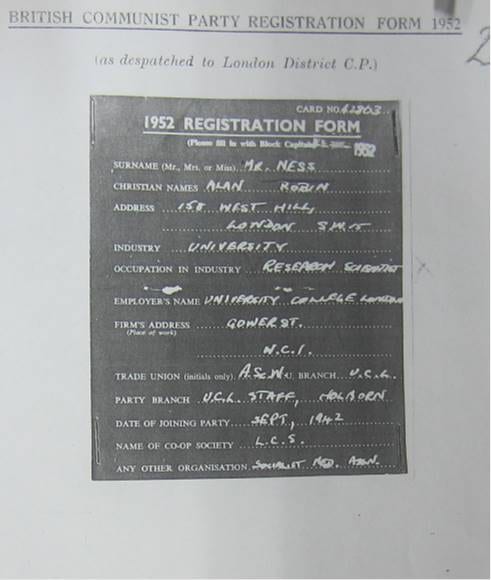
Alan Ness’s Communist Party registration form, 1952. He is listed as a ‘research scientist’. In addition to being a Party member he has joined the Association of Scientific Workers trade union.
Ness was a minor concern for MI5. He partook in the social and political activities of the Party: attending a World Youth Fair in Budapest, wrote letters to MPs as part of a British Peace Committee campaign, sent another letter to the US Ambassador about the Korean War, and protested at the Spanish Embassy in support of strikers in Barcelona. In the early UCL years we encounter him as he wanders into view during the surveillance of others. We overhear him complaining to the Party that he feels overworked and overtired, and that he wants to suspend being secretary of the UCL CP faculty branch so that he can get his first academic paper out. The subsequent discussion of possible replacements provides a map of communist staff at UCL in the early 1950s, including the physicist Franz Heymann and the biologist John Maynard Smith.
Ness attracted greater attention when he became a friend of Alan Nunn May. The atom spy had been released from prison (with hard labour) in 1952. Alan and his wife Christian (Hamp, whom he married in the same year) got on well with Nunn May and his partner, Hildegard. MI5 tapped the Ness’s phone and opened their mail. The surveillance net around the atom spy was intense. When Alan and Christine attended the Nunn Mays’ marriage, in Cambridge, it is clear from the report that an informant was even at the ceremony and reception.
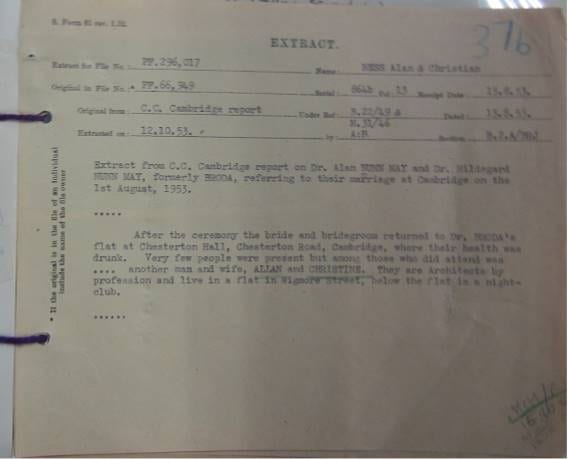
The surveillance of Alan Nunn May extended to spying on his wedding. Here the informant reports that Alan and “Christine” (Christian) Ness attended the wedding and sparse gathering that followed. The informant clearly pumped the Nesses for information, such as where they lived and what they did (in fact, only Christian was an architect)
The thorough surveillance means that intimate documents, ones which would otherwise have been guarded or destroyed, have been archived. Such documents reveal the tensions between personal, professional and political life, and make them accessible to historians. For example, in 1954 Christian’s father, Stanley Hinge Hamp (4), wrote a heartfelt plea to Alan which speaks of his paternal concern for his daughter, her potential as an architect, the stress that she was under, and, most interestingly his view that Alan had ‘already made her a fellow traveller, but sooner or later she will see through it all and tragedy may be the result’.
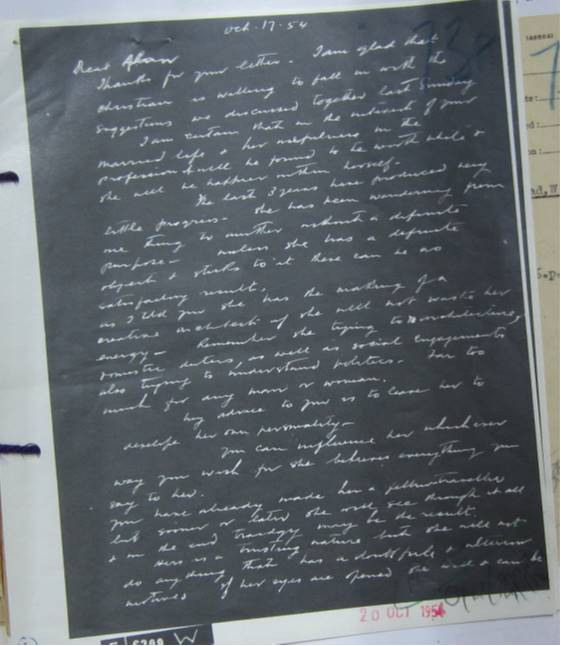
Christian’s father’s letter to Alan Ness (page 1). “Dear Alan, Thanks for your letter. I am glad that Christian is willing to fall in with the suggestions we discussed together last Sunday. I am certain that in the interests of your married life and her usefulness in the profession it will be found to be worthwhile and she will be happier within herself. The last 3 years have produced very little progress. She has been wandering from one thing to another without a definite purpose – unless she has a definite object and stocks to it there can be no satisfactory result, as I told you she has the making of a creative architect if she will not waste her energy – Remember she [is] trying to do architecture, domestic duties, as well as social engagements also trying to understand politics. Far too much for any man or woman. My advice to you is to leave her to develop her own personality. You can influence her which ever way you wish for she believes everything you say to her. You have already made her a fellow traveller, but sooner or later she will see through it all and in the end tragedy may be the result. Hers is a trusting nature but she will not do anything that has a doubtful and ulterior motives. If her eyes are opened she will and can be …”
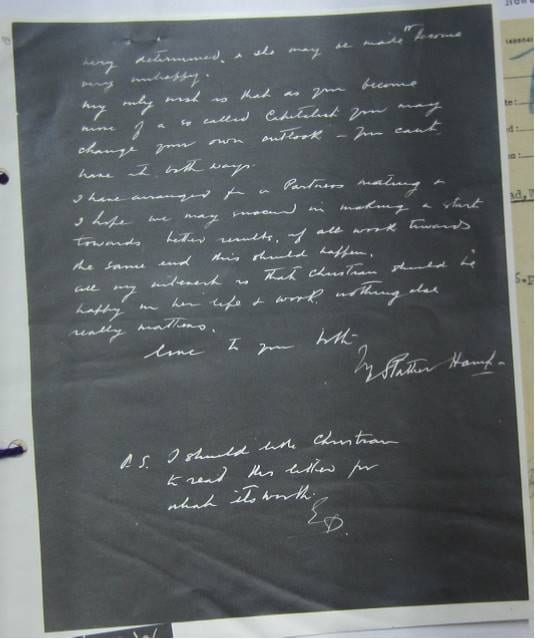
Christian’s father’s letter to Alan Ness (page 2) “… very determined, and she may be made to become very unhappy. My only wish is that as you become more of a so called Capitalist you may change your own outlook – you can’t have it both ways. I have arranged a Partners meeting and I hope we may succeed in making a start towards better results, if all work towards the same end this should happen, all my interest is that Christian should be happy in her life and work. Nothing else really matters. Love to you both. Stanley Hamp”
Christian Ness would, in fact, combine all her so-called ‘duties’ successfully: she continued as an architect (with a brief interruption), and completed some significant commissions, notably the modernist Hampden Hill estate in Beaconsfield in the early 1960s, as well as work on the Russian Shop in Holborn in 1962. Already active in Architects Society for Peace and Construction, she joined the Communist Party in 1954.
In that year, Alan, wanting to focus on his PhD, passed on the post of secretary of the UCL staff branch of the Communist Party to John Maynard Smith, at which point the telephone and postal surveillance of Alan Ness was stopped.

Alan Ness (front row, second from right) 1966 Source: http://www.physoc.org/media/remembering-sir-andrew-huxley-july-1966-university-college-london
(2) The Science Superstar
John Burdon Sanderson Haldane – JBS Haldane – had been tracked by MI5 and Special Branch since 1928, when he was at the University of Cambridge. He arrived at University College London in the early 1930s as Professor of Genetics (later Biometry). He was a tireless speaker for left-wing causes, and wrote regular science articles for the Daily Worker, back when scientific journalism was new. He was a very prominent, public Marxist, close to the CPGB leaders.
The surveillance of JBS Haldane is full of the ironies of the spy game. A 1946 letter from a M.B. Towndrow tipping MI5 off that Haldane had been invited to an international congress on philosophy in Rome, where he ‘might possibly be asked by the British Communist Party to make contact with the Italian Communist Party’, was addressed to Kim Philby, who would be revealed as the third man of the Cambridge spy ring when he defected in 1963.
In 1948, Haldane was at the centre of a failed British pseudo-McCarthyite witch hunt. In March, the Daily Express reported Haldane as saying:
I certainly am a Communist – as good a Communist as anyone. I am working on two Government scientific sub-committees, one of which deals with under-water physiology. They don’t pay me anything, and they can throw me off if they want to. … They can go on sacking people, but the only result will be that all sorts of people will be denounced as Communists when they are not. If I got orders from Moscow, I would leave the Communist Party forthwith. But sometimes I wish we did get orders from Moscow. I would like to know what they are thinking. The only group of people in this country who get orders from foreign Powers are Roman Catholics. (5)
In April, the fabulously named Sir Waldron Smithers (6), who urged the formation of a Select Committee for Un-British Activities, lodged a PMQ to Clement Attlee asking the Prime Minister ‘if he is aware that Professor Haldane, an avowed Communist, is working on two Government scientific committees; and what action he proposed to take’? (7) When Attlee responded that he had nothing to add to previous statements of policy, Smithers replied, citing the Daily Express quotation, asking whether Attlee was ‘not aware that purges, to be effective, must apply to people like Professor Haldane?’ (8). Attlee again refused to change course. When Smithers asked a second question in May 1948, this time urging Attlee to ‘extend the purge of the Civil Service to members of Government advisory committees and the BBC’, an (unidentified) honorary member of the House of Commons, heckled: ‘And to the Tory back bench’. (9)
The immediate threat of British McCarthyism receded. But following years would be a extremely difficult for Haldane – public figure, Marxist, geneticist – because of the great set-piece of Cold War science anti-communism: the Lysenko affair. Trofim Lysenko, the agronomist who promised revolutionary new methods to grow crops to feed the Soviet people and who won Stalin’s personal support, was at the height of his baleful influence.
On 30 November 1948, Haldane appeared on a BBC Third Programme broadcast on “The Lysenko Controversy”, alongside R.A. Fisher, Cyril Darlington and Sydney Harland. (10) Haldane spoke last, after the first three eminent scientists had lambasted Lysenko. He also rejected Lysenkoism, although he ended his criticism with a compromised tone: it ‘doesn’t mean that we can neglect his work, or that of [the proto-Lysenkoist] Michurin’. The broadcast caused consternation in the offices of the Communist Party of Great Britain. We know this because the offices were bugged, and we have the transcript of what was said:
JAMES KLUGMAN was talking to BILL WAINWRIGHT. JAMES was critical of HALDANE’s speech on LYSHENKO [sic]. He said that his speech sounded liberal because it was made after three fire-eaters had had their say. He felt that there was danger of HALDANE being chased away from the Party… BILL said that he had listened to HALDANE’s speech last night and his opinion was that it was a step in advance of any previous position he had taken. JAMES did not agree, although he admitted HALDANE, knowing he was speaking to the enemies, was putting forward as much of the positive side of his attitude as he could. … JAMES said if he were in such a position he would either shut up or put forward the Party’s line with which he disagreed. Where he blamed HALDANE so much was that he had failed to do this. BILL continued to stick up for HALDANE… (11)
The problem, as most Party leaders saw it, was that Haldane was a public figure who was not following the Party line:
JAMES said that the fact that a well known Communist Scientist like HALDANE should have differed from LYSHENKO would give the reactionaries all over the world an opportunity to attack them. HALDANE must be persuaded to come and consult the Party before he took part in any future public debates or made any statements.
(The transcribed eavesdrop ends with Klugmann and Wainwright joking that perhaps they should advertise Lysenko’s book in The Times, The Listener, and the agricultural and gardening journals: ‘they could sell big enough quantities to enable them to retire on the proceeds for life!’)
For Haldane, however, the problem was one of independence. He fell out with J.D. Bernal on the question of Lysenkoism in 1949. He wrote (and withdrew) letters of resignation to the Party. Yet despite his claim that any political pressure from Moscow would prompt him to leave the Party, the Party nevertheless exerted such pressure. For example, in 1953, Haldane was called in to see Harry Pollitt, the General Secretary of CPGB and Stalinist. The record (again a report from an eavesdropper, presumably via a bug), makes uncomfortable reading:
HARRY told HALDANE that the Soviet Academy of Science had asked him officially to approach HALDANE and invite him to go for a holiday to the Soviet Union. HALDANE said hastily with a lot of stammering that he would not be able to take a holiday this summer. HARRY said “You won’t?” in surprise and added that this was very important. HALDANE stammering more than ever, said he knew it was important but he had to keep his laboratory going… HARRY said rather rudely that he saw the sort of jam that HALDANE was in but “you are a Party man, you know”. He suggested September. (12)
Haldane was routinely tracked and surveilled. He also knew this to be the case. A delightful example comes from 1951. Haldane spoke at a Science for Peace meeting at Conway Hall, Holborn, on the topic of the Korean War. The meeting was packed: there were 300 in the Hall, and 150 more in an overflow room. The MI5 file has two reports of what was said. The first came from someone at the American Embassy, London. Haldane railed against ‘the futility and stupidity of the secrecy which cloaks the scientific endeavors in the Atlantic Pact [NATO] countries today’ (13). He illustrated the point with several anecdotes, one of which was on the sex lives of fungi, that the American spy thought only ‘allegedly humorous’. Haldane then turned to the subject of atom spies. “Nunn May”, he said, “was a fool”. Moreover, he
would not be surprised at all to learn that the United Kingdom had secret agents in the USSR trying to spy out Russian scientific achievements. Conversely, it was quite possible that the USSR had a few such persons in the United Kingdom (Laughter)
Indeed (and here we have to picture the MI5 officers reading this report), the problem was not scientists but their political masters:
With respect to security generally in the United Kingdom, [Haldane] commented as to the absurdity of the efforts of MI5 (British Counterintelligence). He [Haldane] assured the audience from personal observation and experiences over a period of years of association with classified government projects that the procedures and investigative methods of government agencies such as MI5 (“in this country and elsewhere”) are not really capable of uncovering really clever people. The people who are really responsible for so-called breaches of security are people in high places who whisper things to their friends to impress the latter.
Here the ironies start rebounding. The second, more detailed report of the meeting, probably by a Special Branch or MI5 officer, has Haldane defending scientists and also making a remarkable offer, which is worth quoting at length:
Leakages of information took place, not from scientists but from other high levels. He had had three personal experiences where in one instance a high ranking Government Official had informed him, although aware of his political opinions, of the development of radar, another … [of] nuclear fission. If there was a representative of MI5 in the audience who wanted these three names and addresses, Professor Haldane would be pleased to give them after the meeting.
He knew, as everyone knew, that scientists were not spies. They weren’t clever enough, and were too absent minded. They could never remember the code word, so MI5 were wasting its time restricting the legitimate activities of research workers and would do better to screen politicians, letting those whose business it was to develop and create to get on with it. Restrictions would kill science, and when true science died, the world would also perish. (14)
MI5 was not concerned with the question of whether secrecy would kill science, and thereby end the world. The counterintelligence organisation was in a quandary, however, about whether to take up Haldane’s offer of his own intelligence. At this point crucial parts of the file are redacted, and we don’t know what happened next.
(3) The Third Scientist
If Alan Ness was the ordinary communist and J.B.S. Haldane was the Marxist scientist superstar, then Eric Burhop was the middle-ranking UCL researcher who was unfairly suspected of a serious security breach and stepped unwittingly into controversy. Burhop was Australian, who had trained at the Cavendish and whom his fellow countryman, the physicist Mark Oliphant, had brought into the Manhattan Project during the Second World War, where he had worked alongside Harrie Massey, yet another Australian. When Massey returned to UCL in 1945, he brought Burhop back with him, first in the mathematics department and then part of the team that built up UCL’s post-war physics department.
Of all the UCL scientists, Burhop’s MI5 files are by far the most numerous and fattest (15). As a communist atomic scientist this scale of surveillance is not in itself surprising. Initially, Burhop’s surveillance is low-level and routine. It was noted, for example, that he had appeared alongside J.D. Bernal at a British-Soviet Society meeting, where he spoke on the subject of atomic warfare, opposing the existence of American atom bombers being stationed on British airfields. When an Evening Standard reporter challenged Burhop, asking him whether he was a communist, Burhop declined to answer except to say “A man’s politics, like his religion, are a private matter”.(16)
But as the Fuchs case broke, so the surveillance of British atomic scientists stepped up, and permission was granted to tap Burhop’s telephone.
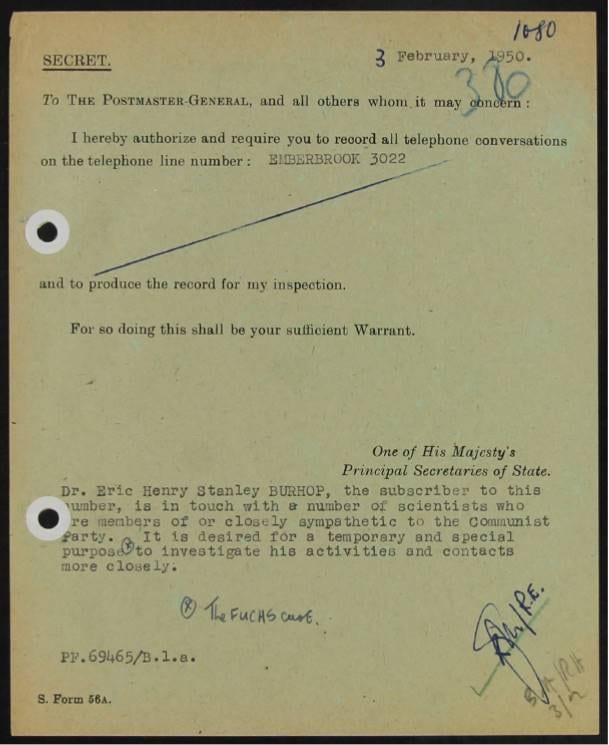
Request for permission to tap Burhop’s telephone. Note the ‘temporary and special purpose’ has been asterisked as the ‘Fuchs case’. 3 February 1950.
But in 1951, state security interest in Burhop increased dramatically. The cause was the surfacing of old FBI tittle-tattle, which said:
As late as 1945, an Australian atomic scientist who worked on an Atomic Energy project was in close touch with Communist Party members in Brooklyn, New York, and through them with the highest Communist officials in the United States. The Australian atomic scientist passed on everything he knew about our Atomic Energy Programme including ‘the setup in New Mexico’ [ie Los Alamos]. The Australian scientist is no longer in the United States. He was in this country in 1943, 1944 and 1945, and made his contacts at the Thomas Jefferson School in New York City. He may be of the Jewish faith.
Attention now focussed on the group around Oliphant, including Oliphant himself, Massey, four others, Burhop, and (given that an American could hardly be expected to distinguish the accents) the New Zealander Maurice Wilkins.
Surveillance of Burhop was now intense. Not only was his phone tapped, but he was also followed by plain-clothed Special Branch officers as he travelled from home to UCL and back again.
One report, for example, records that Burhop – “Age 40, height 6ft 1 ins, well built, round face, ruddy complexion, eyes brown, hair brown, thin on top, thick at the sides, small nose, clean shaven. He walks with a slight stoop and takes noticeably short sides. He usually carries a small brown attache case and raincoat. Wears herring-bone tweed sports coat and grey flannels, brown shoes” – had left his Surbiton home at 9am and walked to Surbiton station en route to UCL. Another report says
BURHOP was seen at 1pm making a telephone call and 55 minutes later was picked up leaving the Canteen. He walked to the Westminster Bank, Tavistock House, Upper Woburn Place. He was back at College by 2.5pm.
(Note the implication of this report that the Cold War security services were trailing Burhop within UCL itself. Another report detailed that Burhop had not left Gower Place up to 10.30pm, although there were ‘many exits and we cannot cover every one’ and there had also been a dance at the College that night, which suggests that, in this instance, plain-clothes officers were waiting at the gates.)
When Burhop decided that he wanted to travel to Moscow in 1951, the security services were sent into a flap. The Australian authorities were prevailed to cancel his Australian passport, but Burhop secured a British replacement. Herbert Morrison, the Foreign Secretary, decided to cancel the new document. The case somehow made the press, and controversy followed, with legal challenges and questions being asked in Parliament. Burhop, interviewed in the Daily Herald, described the situation as ‘awkward’.
From the authorities’ point of view, here was an atomic scientist who wanted to visit Moscow and might be ‘persuaded to stay’. Yet the resolution of this affair was remarkably mild, in contrast, say to the Oppenheimer case in the United States. Burhop was eventually issued a new passport, but he also ‘gave his word’ to let the Foreign Office know if he was planning to travel ‘to any country in the Soviet sphere’. It seems very gentlemanly. But at least one astute observer within government, the civil servant B.K. Blount, of the Directorate of Scientific Intelligence, summed it up more critically:
The maintenance of personal freedom, and particularly of the right to leave one’s own country and to travel, is one of the main points in our “cold war” position. It seems to me that in our handling of this case we have provided our opponents with some welcome ammunition.
Yet the original cause of all this anxiety, the rogue accusation of an ‘Australian’ associated with the Manhattan Project, was never resolved. Further investigation took place, notably in 1953, but neither identification nor refutation were ever made. Certainly there was no positive evidence that Burhop was the spy. Yet the suspicion alone was enough to bring the Cold War to the UCL campus.
(1) The figure for scientists who were CP members in 1955 comes from reference to a list of 87 names to which the Communist Party Science Bulletin was mailed in May 1955. National Archives (hereafter NA) KV 2/4301.
(2) The Ness files are in NA KV 2/4300 and NA KV 2/4301.
(3) For the National Register, a compilation of names and addresses of the UK population against which identity cards were issued, see: Jon Agar, ‘Modern horrors: British identity and identity cards’, in Jane Caplan and John Torpey (eds.), Documenting Individual Identity: the Development of State Practices since the French Revolution, Princeton: Princeton University Press, 2001
(4) Stanley Hinge Hamp had a long career, in which he was first assistant and then partner with the architect Thomas Edward Collcutt, who designed the Imperial Institute in South Kensington. Collcutt & Hamp worked on the Savoy in the early 20th century, as well as the Wigmore Hall. Alan and Christian Ness lived at 126 Wigmore Street before moving to 37 Newton Street.
(5) ‘Haldane: let them sack me’, Daily Express, 16 March 1948.
(6) No relation to Waylon Smithers, of The Simpsons fame.
(7) The two bodies were sub-sub-committees of the Medical Research Council (MRC): the Protection Sub-Committee on the Medical and Biological Applications of Nuclear Physics, and the Underwater Physiology Sub-Committee of the Royal Naval Personnel Research Committee.
(8) Hansard, House of Commons, 26 April 1948. In March 1948, following discussion in Cabinet, Attlee had introduced a “Purge Procedure” ‘excluding both Communists and Fascists from work “vital to the Security of the State”‘. Christopher Andrew, The Defence of the Realm: the Authorized History of MI5, London; Allen Lane, 2009, p. 383.
(9) Hansard, House of Commons, 4 May 1948.
(10) R. A. Fisher was Professor of Genetics, University of Cambridge. Cyril Darlington was
Director of the John Innes Horticultural Institution (a successor to Haldane), and Sydney Harland was Director of the Institute of Genetics in Lima, Peru. All were Fellows of the Royal Society.
(11) Transcript, by F1A section of MI5, 2 December 1948. NA KV 2/1832. JAMES was James Klugmann, was a member of the executive committee of CPGB and later the Party’s official historian. BILL was Bill Wainwright, who had studied chemistry, would become Assistant General Secretary of CPGB in 1956.
(12) Transcript, by FIA section of MI5, 5 July 1949. NA KV 2/1832.
(13) Letter, Unknown (American Embassy, London) to John Marriott (MI5), 3 December 1951. NA KV 2/1832. Also speaking at the Science for Peace meeting were the botanist Frederick Gugenheim Gregory, the physicist C.F. Powell, and J.D. Bernal, who spoke from the floor.
(14) Excerpt (incomplete) of report on Science for Peace meeting, 1951. NA KV 2/1832.
(15) NA KV 2/3228 – KV 2/3239.
(16) ‘Atom scientist’, Evening Standard, 10th October 1949.
One Response to “Science and the Cold War at UCL. 1. Surveillance”
- 1
 Close
Close


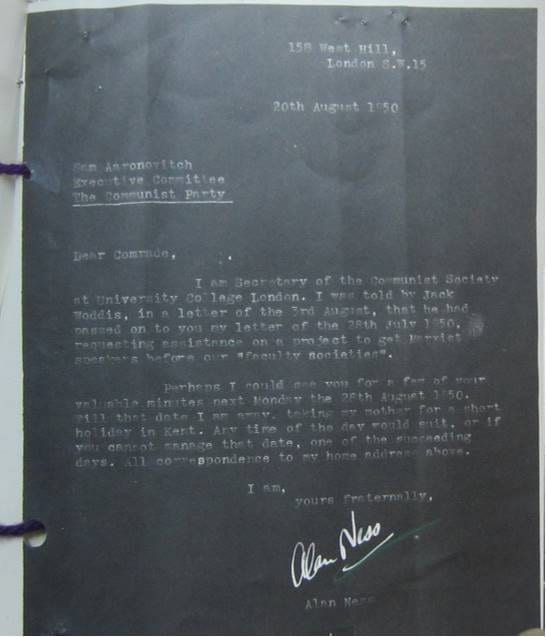
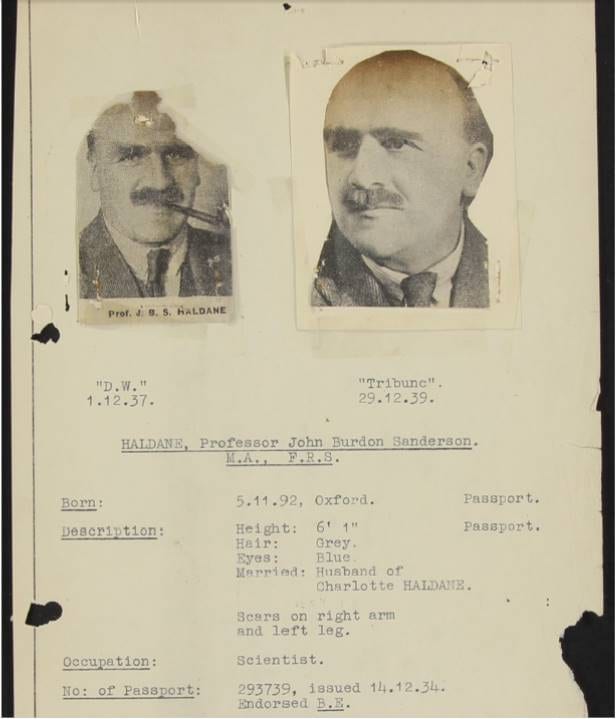
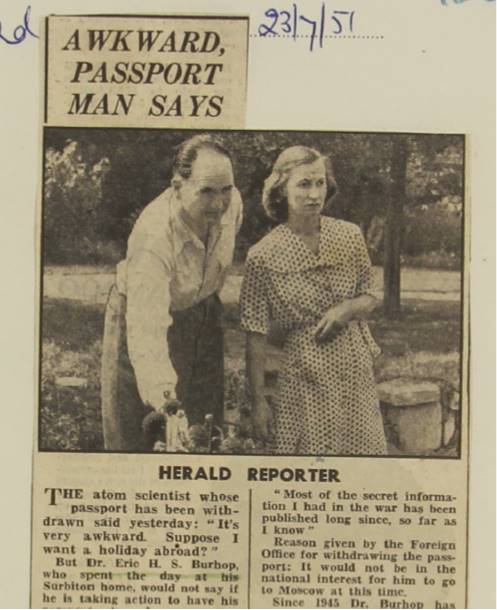
[…] UCL: STS Observatory: Science and the Cold War at UCL. 1. Surveillance […]